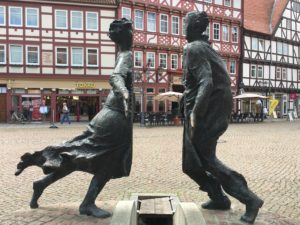 Duderstadt: A small town just west of the former border. There is much to see here, especially the well-preserved and maintained timber-framed houses with an impressive variety of artistic detail. I look for and find the “reunification fountain,” a bronze sculpture by the artist Karl Henning Seemann. The sculpture shows a male and a female figure moving towards each other, but kept from each other by an invisible wall. For the artist, the scene depicts the difficulties that became apparent in the process of reunification, but also the unique and historic opportunity.
Duderstadt: A small town just west of the former border. There is much to see here, especially the well-preserved and maintained timber-framed houses with an impressive variety of artistic detail. I look for and find the “reunification fountain,” a bronze sculpture by the artist Karl Henning Seemann. The sculpture shows a male and a female figure moving towards each other, but kept from each other by an invisible wall. For the artist, the scene depicts the difficulties that became apparent in the process of reunification, but also the unique and historic opportunity.
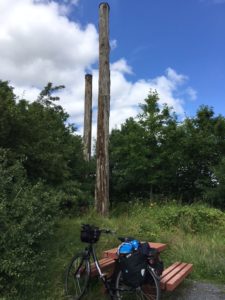 Another symbolic site, not far from Duderstadt at the top of a gently sloping hill, right on the former border: The West-Eastern Gate. In 2002, two tall oak posts were placed here to form an open gate, and a number of beech saplings were planted around them. The growth of the young beech trees was meant to symbolize the treasure of the Green Belt and the hope for harmonic integration of East and West in Europe. Mikhail Gorbachev, who was instrumental in setting the conditions that made the opening of the border possible, officiated at the opening of the West-Eastern Gate and was made patron of the Green Belt.
Another symbolic site, not far from Duderstadt at the top of a gently sloping hill, right on the former border: The West-Eastern Gate. In 2002, two tall oak posts were placed here to form an open gate, and a number of beech saplings were planted around them. The growth of the young beech trees was meant to symbolize the treasure of the Green Belt and the hope for harmonic integration of East and West in Europe. Mikhail Gorbachev, who was instrumental in setting the conditions that made the opening of the border possible, officiated at the opening of the West-Eastern Gate and was made patron of the Green Belt.
By now the beeches have nearly caught up in size with the oak posts, but this kind of organic transformation was part of the idea. Another visitor on a bike approaches and stops. Together, we take in the stillness of the place. When I ask what memories he has of the time of the German division, he tells me that when he was thirteen, he was experiencing his first budding romance with a girl from East Berlin whose family was vacationing in the West German state of Hesse, where he lived. It was the summer of 1961. One day the family received a call informing them that a wall was being built through Berlin. Until then, people had been able to cross back and forth between the three Western sectors of the city and the Soviet sector. Now this was no longer possible, and the girl’s family was in absolute turmoil because they could not go home and did not know where else to go. The man doesn’t know what became of the family or the girl.
As we sit quietly again, I notice a large bird sailing elegantly above us. Its forked tail makes it look a bit like an oversized swallow, but the head is raptor-like and this bird flies much more calmly and slowly. Most likely it is a Rotmilan (Milvus milvus) – known as red kite in the U.K. – a bird of prey that occurs only in Europe and whose habitat keeps shrinking. Its German population was on the decline in the 1990s but is reported to have stabilized, probably in no small part thanks to the Green Belt. You can see a picture (and read more about the Rotmilan auf deutsch ;-)) on this website.
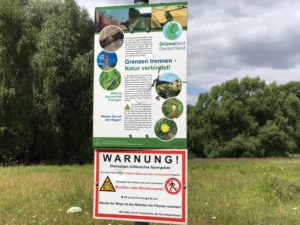 My route for the next several miles goes right down (and up) the Kolonnenweg, the parallel concrete tracks once used by border patrol vehicles. The concrete slabs have a hole pattern that makes for a bumpy ride, and the former border went straight up and down several hills in this area. I notice a post with two signs: One with information about the Green Belt; the other a warning sign urging visitors to stay on trails because despite repeated searches, not all land mines from the former border fortifications may have been located.
My route for the next several miles goes right down (and up) the Kolonnenweg, the parallel concrete tracks once used by border patrol vehicles. The concrete slabs have a hole pattern that makes for a bumpy ride, and the former border went straight up and down several hills in this area. I notice a post with two signs: One with information about the Green Belt; the other a warning sign urging visitors to stay on trails because despite repeated searches, not all land mines from the former border fortifications may have been located.
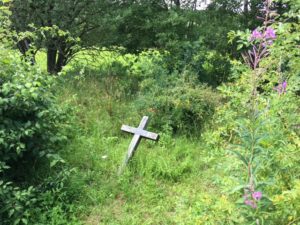 A few kilometers on, I notice something out of the corner of my eye that looks like a cross. I turn my bike around and find that it was indeed a cross, and that it was placed there to commemorate a young NVA (National People’s Army) soldier named Andre Roessler, who tried to cross the border here one night in April of 1976 and was killed by one of the automatic firing devices installed on the outer fence. Nearby, an interpretive sign quotes a Stasi (East German secret police) officer expressing concern that word of the incident might get out to the Western media, and giving orders to keep the young man’s parents “under control”.
A few kilometers on, I notice something out of the corner of my eye that looks like a cross. I turn my bike around and find that it was indeed a cross, and that it was placed there to commemorate a young NVA (National People’s Army) soldier named Andre Roessler, who tried to cross the border here one night in April of 1976 and was killed by one of the automatic firing devices installed on the outer fence. Nearby, an interpretive sign quotes a Stasi (East German secret police) officer expressing concern that word of the incident might get out to the Western media, and giving orders to keep the young man’s parents “under control”.
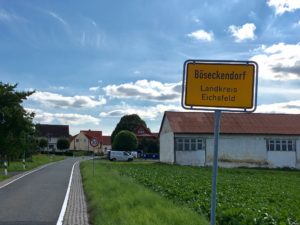 I ride on, weighed down by the heaviness of this kind of brutality. A few kilometers later, I find myself cheered up by a sign announcing the village of Böseckendorf. I had read about the incredible escape across the border of half the village’s population (53 people, to be exact) in 1961. No one I asked could tell me exactly how they did it, except that they got wind of imminent plans to fortify the border in their area, and someone knew a place where it was not closely guarded. Just as incredibly, 12 more people were able to escape in 1963.
I ride on, weighed down by the heaviness of this kind of brutality. A few kilometers later, I find myself cheered up by a sign announcing the village of Böseckendorf. I had read about the incredible escape across the border of half the village’s population (53 people, to be exact) in 1961. No one I asked could tell me exactly how they did it, except that they got wind of imminent plans to fortify the border in their area, and someone knew a place where it was not closely guarded. Just as incredibly, 12 more people were able to escape in 1963.
And there is yet another story of inspiring citizen action nearby: The so-called “Kofferdemo” (suitcase protest). In January of 1990, two months after the fall of the Berlin Wall and the opening of the first border crossings, many people in East Germany were getting frustrated with the slow pace of reforms and the continued presence of the SED (Socialist Unity Party) in government. That day in January, an estimated 50,000 people showed up at the Duderstadt-Worbis border crossing and walked across to West Germany on foot, suitcases in hand, to signal that they would leave permanently if things did not change. Many people had already left, and the protesters wanted to prevent a further drain on the region’s population. Some began to call for reunification. Remember, actual reunification did not take place until October 3 of that year – this was a time when everything was wide open. More on this soon…

Very exciting project. Fascinating, moving and poignant. Your project has much potential to connect peoples everywhere.
Hi Kerstin,
Really enjoying your blog. If you haven’t obtained it already, grab a copy of Anna Funder’s “Stasiland”–it is available in German translation from the original English, and the translation is quite good. Interviews of Stasi personnel with great care and attention to human details. With all the sensitivity of Das Leben der Anderen, by Florian with the long name.–Dennis
Thanks for your interest Dennis; I am glad you are enjoying the blog! Yes, “Stasiland” is an excellent book; I read it around the time I started the expedition. Heavy stuff…
Greetings, Kerstin. Thought-provoking again to read about your travels along the former border.
The gendering of the reunification fountain in Duderstadt raises questions. Did the figures represent different sides of the border, and, if so, what does it mean that the former East Germany was of one gender and the former West of another? If they did not represent different sides, the fact that a single female and a single male were used to represent the sides still seems significant. Why, I wonder, were not groups of people shown on each side? Is this of any sociocultural significance?
The 1961 escape from Boseckendorf made me think of a topic that I am now looking at in Romania: return migration. Have any of the people who escaped come back, temporarily or permanently, and, if so, what have their experiences entailed socially, economically, and culturally?
One last question, at least for now: I believe you have written about, or we have talked about, the Greenbelt already, but can you give a brief description of what exactly this is? Is it similar to the DMZ between North and South Korea, where animals and plants that have lost habitat in other places have been able to thrive?
Look forward to your next entry.
Hugs,
Gerard
Hi Gerard,
I wondered about the choice of a male and female figure as well. Rather than tell you my guesses, I contacted the artist… stay tuned!
Regarding return migration, I have heard about it anecdotally from people I have spoken to, but don’t know much (yet) about their experiences in any detail. Incidentally, DIE ZEIT just had a graphic and a short article on return migration for all of Germany: http://www.zeit.de/zeit-magazin/2017/30/rueckwanderung-heimat-ostdeutschland-westdeutschland-deutschlandkarte
Interestingly, the region with the highest rate of return migration is the Eichsfeld. This is also where the American anthropologist Daphne Berdahl did her field work in the early 1990s and on which her book “Where the World Ended” is based.
Regarding the Green Belt, I think that deserves its own post and will write about it very soon!